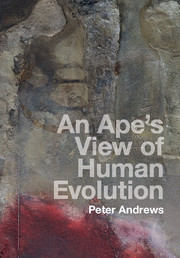Book contents
- Frontmatter
- Contents
- Preface
- 1 How can we recognize common ancestors?
- Part I Apes: their morphology and behaviour
- 2 Morphology and behaviour of living apes
- 3 Human and ape phylogenies
- 4 Review of fossil apes
- PART II Environments and palaeoenvironments
- Part III Review of fossil apes
- Part IV Last common ancestor
- References and further reading
- Index
- References
2 - Morphology and behaviour of living apes
from Part I - Apes: their morphology and behaviour
Published online by Cambridge University Press: 05 January 2016
- Frontmatter
- Contents
- Preface
- 1 How can we recognize common ancestors?
- Part I Apes: their morphology and behaviour
- 2 Morphology and behaviour of living apes
- 3 Human and ape phylogenies
- 4 Review of fossil apes
- PART II Environments and palaeoenvironments
- Part III Review of fossil apes
- Part IV Last common ancestor
- References and further reading
- Index
- References
Summary
We have seen in the previous chapter that in order to reconstruct the relationships of living apes and humans, it is necessary to look both to the living species and to fossil apes. The next two chapters are entirely concerned with the morphology, behaviour and genetics of living apes, gibbons, orang utans, chimpanzees and gorillas, with some notes on humans (upright bipedal apes) as well. This will lead to their formal classification, which also includes some of the fossil apes that are discussed in Chapter 4.
Extant apes
Living species of apes have an exclusively tropical distribution and are divided between the Asian apes, living in tropical forest environments in Southeast Asia, and African apes, living in varied wooded habitats across Central and West Africa and extending into the western borders of East Africa. Living apes and humans are distinguished from other primates through morphological features such as the absence of a tail and presence of an appendix. They share a number of specializations of the skeleton, which are useful as diagnostic characters because bones and teeth are the most readily preserved parts in the fossil record. Orthograde (upright) body posture, broad chests, mobile shoulder regions and short, stiff lower backs are present in all living apes and distinguish them from monkeys. The clavicle (collar bone) is long, the shoulder bone is situated on the back rather than the sides of the chest and the wrist is modified for mobility of the joint. The lumbar vertebrae have robust pedicles, caudally inclined spinous processes and dorsally oriented transverse processes arising from the pedicle. Synapomorphies of the skull include the deep arched palate and relatively small incisive foramina. The teeth are generally primitive, except in the broad incisors and enlarged molars. Recently, it has been demonstrated that soft-tissue anatomy also distinguishes within and between apes and humans, but unfortunately soft tissues do not generally fossilize.
Asian apes include the gibbons and orang utans. They retain many primitive ape characteristics and have also developed a number of unique characters that are different from any other ape, in particular those related with brachiation in the gibbons.
- Type
- Chapter
- Information
- An Ape's View of Human Evolution , pp. 21 - 39Publisher: Cambridge University PressPrint publication year: 2016



